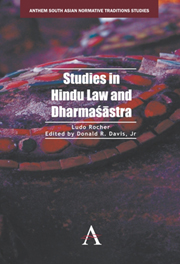Book contents
- Frontmatter
- Contents
- Foreword by Richard W. Lariviere
- Preface
- Abbreviations
- Note on the Edition
- Introduction
- PART ONE THE NATURE OF HINDU LAW
- PART TWO GENERAL TOPICS OF HINDU LAW
- Ancient Hindu Criminal Law
- Hindu Law of Succession: From the Śāstras to Modern Law
- Caste and Occupation in Classical India: The Normative Texts
- Megasthenes on Indian Lawbooks
- The “Ambassador” in Ancient India
- The Status of Minors according to Classical Hindu Law
- Quandoque bonus dormitat Jīmūtavūhanas?
- Notes on Mixed Castes in Classical India
- Inheritance and Srāddha: The Principle of “Spiritual Benefit”
- The Theory of Matrimonial Causes According to the Dharmaśāstra
- Jīmūtavūhana's Dāyabhāga and the Maxim Factum Valet
- The Divinity of Royal Power in Ancient India according to Dharmaśāstra
- A Few Considerations on Monocracy in Ancient India
- PART THREE HINDU LEGAL PROCEDURE
- PART FOUR TECHNICAL STUDIES OF HINDU LAW
- PART FIVE ANGLO-HINDU AND CUSTOMARY LAW
- Bibliography
- Index
Hindu Law of Succession: From the Śāstras to Modern Law
from PART TWO - GENERAL TOPICS OF HINDU LAW
Published online by Cambridge University Press: 05 February 2013
- Frontmatter
- Contents
- Foreword by Richard W. Lariviere
- Preface
- Abbreviations
- Note on the Edition
- Introduction
- PART ONE THE NATURE OF HINDU LAW
- PART TWO GENERAL TOPICS OF HINDU LAW
- Ancient Hindu Criminal Law
- Hindu Law of Succession: From the Śāstras to Modern Law
- Caste and Occupation in Classical India: The Normative Texts
- Megasthenes on Indian Lawbooks
- The “Ambassador” in Ancient India
- The Status of Minors according to Classical Hindu Law
- Quandoque bonus dormitat Jīmūtavūhanas?
- Notes on Mixed Castes in Classical India
- Inheritance and Srāddha: The Principle of “Spiritual Benefit”
- The Theory of Matrimonial Causes According to the Dharmaśāstra
- Jīmūtavūhana's Dāyabhāga and the Maxim Factum Valet
- The Divinity of Royal Power in Ancient India according to Dharmaśāstra
- A Few Considerations on Monocracy in Ancient India
- PART THREE HINDU LEGAL PROCEDURE
- PART FOUR TECHNICAL STUDIES OF HINDU LAW
- PART FIVE ANGLO-HINDU AND CUSTOMARY LAW
- Bibliography
- Index
Summary
0.1 On June 17, 1956 the President of India gave his assent to The Hindu Succession Act 1956 (Act No. 30 of 1956). As stated in the Preamble, it is “an Act to amend and codify the law relating to intestate succession among Hindus.” Both terms are important: “amend” and “codify.” Indeed,
the law before this Act was the law laid down by the Smritikaras and the commentators as modified by custom and usage and as interpreted and applied by judicial decisions. But the law differed from place to place according to the schools exercising their influence in different parts of India. The present Act has attempted to codify the whole law of intestate succession, making it uniformly applicable to all Hindus, with the result that such differences as arose in the past between the schools of law have now disappeared.
(Gupte 1963: 316)Smṛtikāras, commentators, customs, usage, schools of law, judicial decisions: they all are part of the long and checkered career of the law of inheritance and succession in India, which is now amended and codified by The Hindu Succession Act, 1956 (See also Mulla 1959; Derrett 1957, 1963).
- Type
- Chapter
- Information
- Studies in Hindu Law and Dharmasastra , pp. 163 - 200Publisher: Anthem PressPrint publication year: 2012

